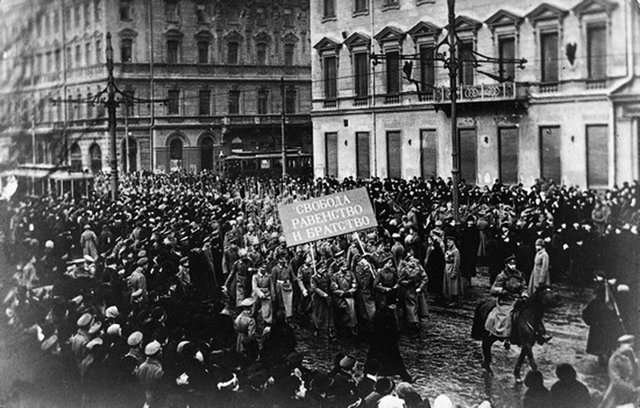History of the Russian Revolution, Peoples’ Right to Self-determination, and Debt Repudiation
Part 4 of the series: Centenary of the Russian Revolution and the Repudiation of Debt

The Versailles Treaty was eventually signed on 28 June 1919 without Soviet Russia being involved. Even so, this treaty cancelled the Treaty of Brest-Litovsk. Under Article 116 of the Versailles Treaty, Russia could claim compensation from Germany;yet, consistent with its demand for peace without any annexation or any claim for compensation, it did not do so. What mattered most to Soviet Russia was that the Treaty of Brest-Litovsk should be cancelled and the territories that Germany had annexed in March 1918 be given back to the peoples to whom they had belonged (the Baltic, Polish, Ukrainian and Russian peoples), in accordance with the principle of peoples’ right to self-determination upheld by the new Soviet government.
Treaties with the Baltic Republics, Poland, Persia and Turkey
This principle was also called upon in the first article of each of the peace treaties signed between Soviet Russia and the new Baltic States in 1920: Estonia on 2 February, Lithuania on 12 July and Latvia on 11 August. The peace treaties resembled one another and the independence of those States – that had been forceably integrated into the Tsarist Empire – was systematically asserted in the first or second article. Through such treaties, Russia reasserted its opposition to the domination of financial capital and its determination to repudiate Tsarist debts. Indeed the treaty that was signed with Estonia on 2 February 1920 states: “Estonia will bear no responsibility for any of Russia’s debts or other obligations (…). All claims of the creditors of Russia for the share of the debt concerning Estonia should be addressed to Russia only.” Similar dispositions appeared in the treaties signed with Lithuania and Latvia. As well as asserting that peoples did not have to pay illegitimate debts that were contracted in their names though not in their interest, Soviet Russia also acknowledged the oppressive role played by Tsarist Russia towards minority nations within the Empire.

Signature of the Tartu treaty between Estonia and Russia, February 2nd, 1920.
To be fully consistent with the principles it upheld, Soviet Russia went even further. In those peace treaties, it committed itself to restoring to the oppressed Baltic nations all property and articles of value that had been removed by the Tsarist regime (especially cultural and academic property such as schools, libraries, archives, museums) as well as personal goods that had been removed from the Baltic territories during the First World War. As compensation for war damage resulting from the involvement of Tsarist Russia, Soviet Russia stated that it would grant fifteen million gold roubles to Estonia, 3 million gold roubles to Lithuania and 4 million gold roubles to Latvia, as well as concessions for those three States to exploit Russian forests across the borders. While Russian State loans to citizens of the Baltic states were transferred to the newly independent governments, the peace treaties signed with Lithuania and Latvia stipulated that claims against smallholders against the former Russian agricultural banks since nationalized should not be transferred to the new governments but “purely and simply cancelled”. The same measures also applied to Estonian smallholders under article 13 of the Peace Treaty with Estonia, which stated that “if, when such Treaties are concluded, Russia grants to any one of these new States or to its subjects special exemptions, rights or privileges, these shall be extended in full immediately and without special agreement to Estonia and its subjects.”
By signing these treaties, Soviet Russia meant to try and break out of the isolation to which it had been confined by the imperialist powers since the October Revolution, while at the same time implementing principles the new state wanted to uphold.. The Baltic States were the first to breach the blockade imposed upon Russia, and those peace agreements opened the way to trade contracts between the various parties. In March 1921, a similar peace agreement was signed between Russia, the Ukraine and Belarus on the one hand and Poland on the other. This document released Poland from the obligation to pay any share of the debts of the former Russian Empire, committed Russia to restoring property that had been removed by Tsarist Russia, and specified that Russia and the Ukraine would pay 30 million gold rubles in compensation to Poland. This treaty was even more significant than the one with the Baltic States, as Poland was seen by the allied capitalist powers as key to the isolation of Russia.

The friendship treaty signed between Soviet Russia and Persia on 26 February 1921 is a further token of Soviet Russia’s determination to contribute to the emancipation of oppressed people and to their right to self-determination. In this treaty Russia officially broke away from the tyrannical policies of Tsarist Russia’s colonizing governments and gave up all its territories and economic interests in Persia. The very first article declares all treaties and conventions between Persia and Tsarist Russia, which denied the rights of the Persian people, to be null and void. Article 8 unambiguously cancelled debts owed by Persia to the Tsarist regime: the new Russian government definitively “renounced the economic policy pursued in the Orient by Tsarist regime, which consisted of lending money to the Persian government, not for the economic development of the country but rather for its political subservience.” |1| Consequently it cancelled all Russian claims on Persia.
Fraternization between soldiers and workers
A few weeks later the Soviet government similarly renounced all liabilities, including monetary, that Turkey had towards Russia as a consequence of agreements signed by the Tsarist government. |2|
Eric Toussaint is a historian and political scientist who completed his Ph.D. at the universities of Paris VIII and Liège, is the spokesperson of the CADTM International, and sits on the Scientific Council of ATTAC France. He is the author of Bankocracy(2015); The Life and Crimes of an Exemplary Man (2014); Glance in the Rear View Mirror. Neoliberal Ideology From its Origins to the Present, Haymarket books, Chicago, 2012 (see here), etc. See his bibliography: https://en.wikipedia.org/wiki/%C3%89ric_Toussaint He co-authored World debt figures 2015 with Pierre Gottiniaux, Daniel Munevar and Antonio Sanabria (2015); and with Damien Millet Debt, the IMF, and the World Bank: Sixty Questions, Sixty Answers, Monthly Review Books, New York, 2010. Since the 4th April 2015 he is the scientific coordinator of the Greek Truth Commission on Public Debt.
Notes
|1| Quoted in Jeff King. 2016. The Doctrine of Odious Debt in International Law: A Restatement, Cambridge University Press, p. 84.
|2| Edward H. Carr. 1952. (A History of Soviet Russia), The Bolshevik Revolution (1917-1923) Vol. 3, Norton Paperback Editions, New York, 1985 (Macmillan, 1953) pp. 311-312.
All images in this article are from the author.


